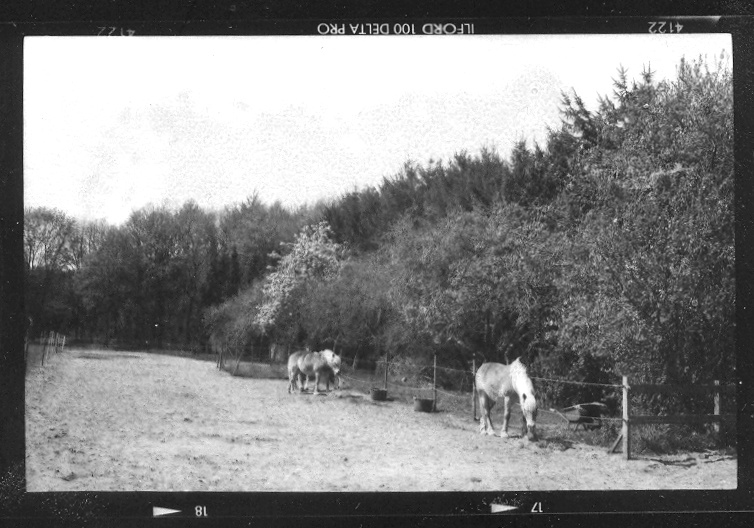Henk Mantel: Elementary, my dear Watson. Elementary!
June 24, 2013I took my time rebuilding the darkroom but so much needed attention around the house. But now I'm back in the darkroom, to check whether or not all the changes that I thought necessary really are effective.
There is a drying cabinet now, complete with fan. Because it is very dry in the darkroom I think a heater isn't necessary. The tabletop has a glass surface now and I invaded the corridor next to the darkroom with two cupboards and workspace to cut glass plates. The E-bayed magnetic stirrer isn't really necessary, but being a non-lab expert, it's great to work with. I fear it is just the beginning of ever more lab equipment.
When making a new batch of KCl emulsion everything went perfect, the ergonomics in the darkroom wonderful, it fits like a glove. But the results, the prints? Disaster, brown spots everywhere, after fixing. Never had this happening to me before. I thought that I did contaminate something chemically.
Back to the basics.
The developer, Adox Adotol, could have been polluted with the fixer. Remembering the old rule if you work from left to right, never ever go into the other direction with tweezers, not even put your fingers into the developer, one drop of fixer and the end of the developer is there. The fixer perhaps? Not so many sheets of paper had gone through it, no.
I used up all the paper I had, because I couldn't believe I did make such a basic mistake. No nothing. No improvement. Now the stop bath, the tray in the middle. I never used citric acid or any acetic acid stop bath. But now with homemade emulsions, perhaps?
I mixed a new batch of emulsion a couple of days later. Stop, I said to myself. Don't ruin another batch, lean back, think. Rethink the process. Ok, the developer acts on the latent image in the emulsion by making the silver in the emulsion visible. Throw the developer away and mix two liters of developer. So that's OK, no problems there. Then, in one liter of distilled water ten grams of citric acid were dissolved. My first stop bath and now my last hope. It should stop development straight away the acid neutralizing the alkalinity of the developer. It could prevent the pollution of the fixer with developer too.
The fixer, it has to remove the non-exposed silver, as far as I know this could be the real culprit, so what with a new fixer?
Done!
You know, all the prints still stained with funny brown spots. Fortunately I used small 6x9 cm negatives. They are from a nice post-war Zeiss Ikon and the camera is easy to handle with commercial film. I'll stick to this frugal size for a while till my emulsion making has become reliable again.
Tonight I'll mix the next batch of emulsion. I'll use the new trays I bought for the processing of the glass plates, clean the tweezers, the thermometer, everything else meticulously, taking care not to pollute my developer tomorrow. But I need someone looking over my shoulder, a kind of Sherlock Holmes smiling warily: Elementary, Watson. Elementary!
We are dealing with a homemade KCl paper emulsion containing light-sensitive grains called silver-halides. Funny though, didn't we put them into the gelatin ourselves, yeah we did! Cherish the TLF Tutorials!
These silver-halides are struck by light during exposure and when developing these halides they are reduced to black metallic silver. Of course there are unexposed silver halides, they have to be dissolved by the fixer and with the final wash in water they are removed from the emulsion. Now the image is permanent. In a nutshell, this is the procedure, where did I create my brown spots?
I can see Sherlock Holmes grinning already.
Next chance! Problem Solved
Everything has been changed, each and every step in a logical follow up of actions. I did change everything but to no avail. More or less exasperated I came to the conclusion that something had happened outside the field of my own range of possible mistakes.
The raw chemicals.
Nothing had been changed except a new batch of silver nitrate that was used to make the last emulsion.
Again I prepared a new batch of emulsion with Silver nitrate from a different supplier. Then I coated the paper and had to wait a night for the paper to dry.
Funny, I still can't get used to work in the darkroom in daytime. It has been a spare-time thing for so long, getting rid of old habits you know. So the next evening it was contact printing time again. I must admit being a bit tense.
There appeared a rather grey but further unblemished print in the developer. Not yet trusting having found a solution, I waited for the print to fix completely. Turned on the overhead white lighting and man o man what a nice print. No discolorations, nothing wrong with it.
Now after a couple of days the print is still in good health. So is the printer!

This has been the most challenging part of my emulsion making adventures. It has been the same as in my old profession: A problem solving process. Encouraged in step by step eliminating possibilities by the resident Sherlock Holmes at the Light Farm: It was a serious challenge Watson, wasn't it. Absolutely Holmes, indeed it was!